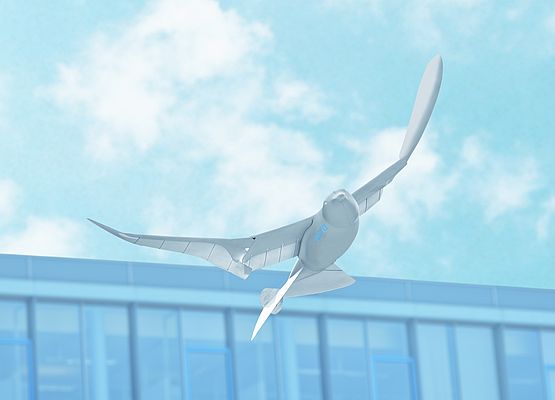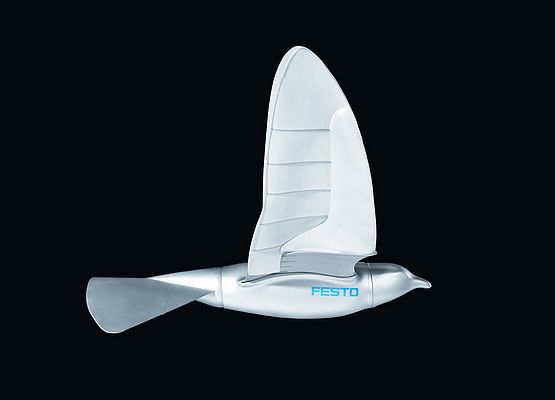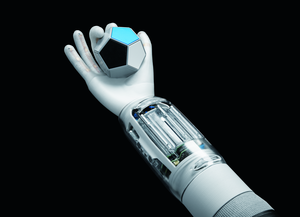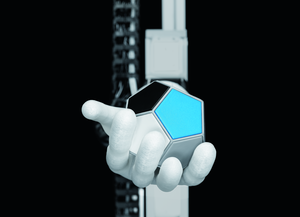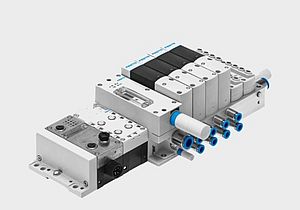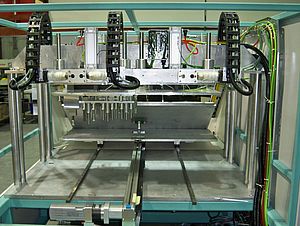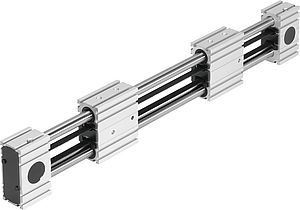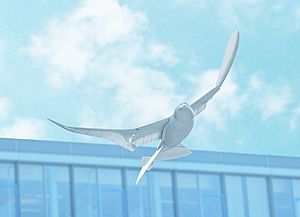Efficiency criteria such as flexibility, low weight in relation to displaced mass, and energy consumption are becoming increasingly important. Nature shows in highly diverse ways how minimum consumption of energy can yield maximum performance. Festo learns from nature's principles in order to transfer its strategy of efficiency to automation technology through Bionics. Its projects demonstrate new technologies which made their implementation possible and are setting the pace in various fields, from safe automation and intelligent mechatronics solutions up to new drive and handling technologies, energy efficiency and lightweight construction.
The fascination of bird flight
One of the oldest dreams of mankind is to fly like a bird. No less fascinating is bird flight in itself. Nature has ingeniously achieved the functional integration of lift and propulsion. Birds measure, control and regulate their motion through the air continuously and fully autonomously in order merely to survive. For this purpose they use their sense organs.
Many scientists failed in their attempts to understand how birds fly, and this secret continued to remain unsolved. The research team from the family enterprise Festo has now, in 2011, succeeded in unravelling the mystery of bird flight. The key to its understanding are two features: it is the active torsion of its wings which realises the unique movement and the fact that it dispenses with the use of additional lift devices.
That distinguishes SmartBird from all previous mechanical flapping wing constructions and allows the ultra-lightweight, powerful flight model to take off, fly and land autonomously.
Unprecedented efficiency in flight operation
SmartBird flies, glides and sails through the air just like its natural model - the herring gull. Its wings not only beat up and down, but also twist at specific angles. This is made possible by an active articulated torsional drive unit, which in combination with a complex control system makes for unprecedented efficiency in flight operation. Festo has thus succeeded for the first time in attaining an energy-efficient technical adaptation of this model from nature.
In developing the model, the engineers were able to draw on their wealth of experience and innovations: as a global player in pneumatics, Festo's mastery of airflow is unparalleled. In the development and production of the latest generations of cylinders and valves, the objective is to make optimal, efficient use of airflow for automation technology.
In practice, this intelligent biomechatronic overall system operates above all in an energy-efficient manner: the coupled propulsion and lift, as intended, are achieved solely by the flapping of the wings and have a power requirement of only around 23 watts. SmartBird has a total weight of around 450 grams and a wingspan of two metres. Measurements have demonstrated an electromechanical efficiency factor of around 45 % and an aerodynamic efficiency factor of up to 80 %. SmartBird is thus an excellent example of functional integration and resource-efficient extreme lightweight design, and demonstrates optimal use of airflow phenomena. It will provide important impulses for the further optimisation of future generations of cylinders and valves.
Possible practical applications in process automation
The onboard electronics ensure precise wing control. In addition, the torsion control parameters can be adjusted and thus optimized in real time during flight. The wing flapping and twisting sequence is controlled to within only a few milliseconds and results in optimum airflow around the wings. The SmartBird flight model has no rotating parts on its exterior and therefore cannot cause injury. It is further pursuing an approach that already played an important role in the development of the Bionic Handling Assistant: human-machine interaction. This feature of both the Bionic Handling Assistant and SmartBird poses no risk to the human operator. SmartBird thus joins the list of Festo's future-oriented technologies that are expected to find practical application. Possible uses range from stroke wing generators in the energy sector up to actuators for process automation.


